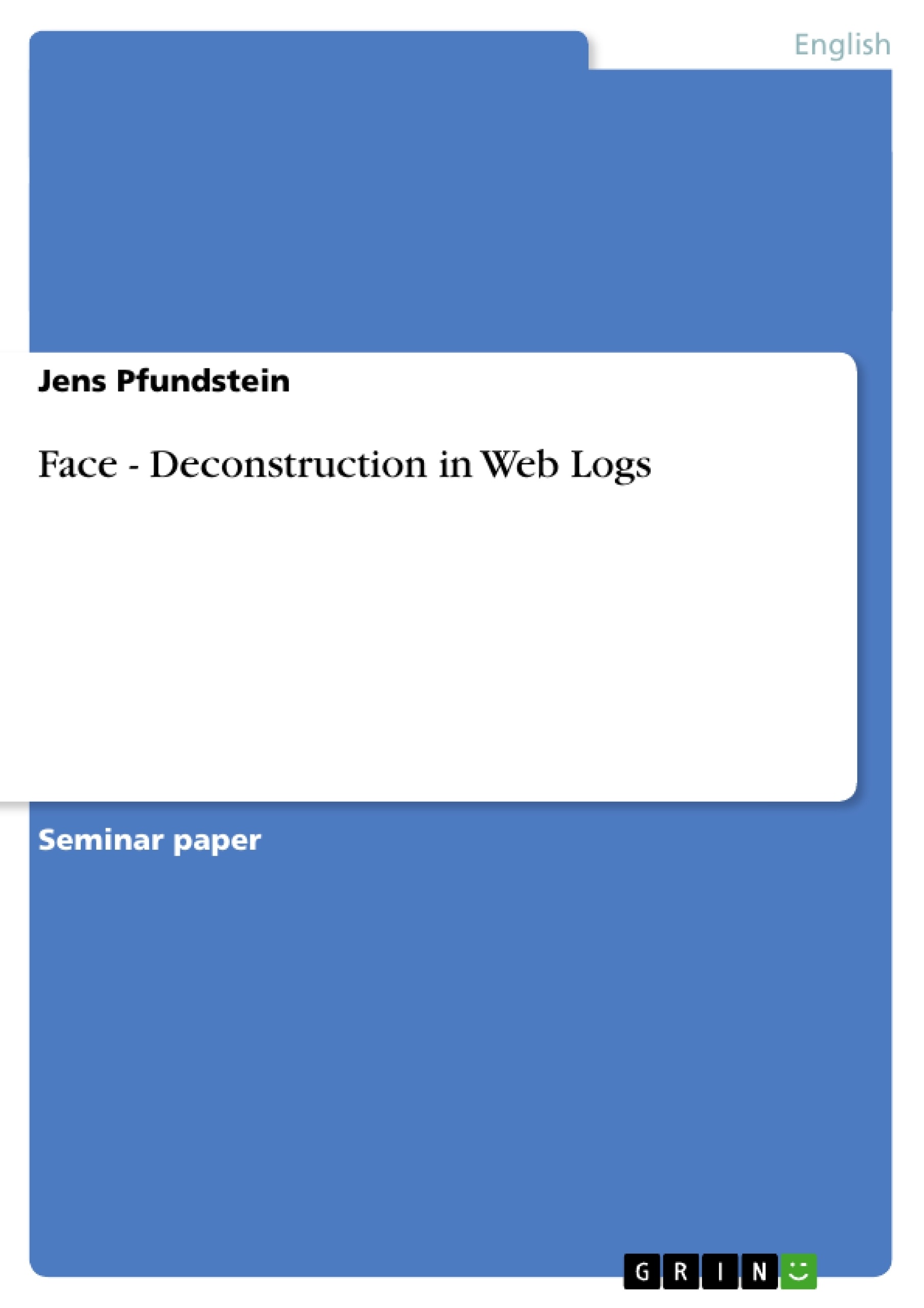In this paper, I will attempt an investigation of the rules of communication that count for web logs. To be more specific, I will concentrate on how face-deconstruction is organized within web logs.
To facilitate cognition, research project and paper are organized along the following lines:
First, I will set up a framework for the research project. In other words, I will provide a suitable definition for the object of investigation. Furthermore, I will state on which web log I concentrate on. I will also describe this particular web log and clarify whether this web log is fit for investigation or not. Moreover, I will determine time range and the scope of investigation.
Secondly, I will provide the necessary concepts, ideas and define the relevant key-words.
Thirdly, I will develop a line of thought and a taxonomy which allows the classification of different types of
face-deconstruction.
Step four consists of an application of this taxonomy to the corpus of data.
Finally, I will conclude this paper with a short summary of my findings.
The appendix I intend to provide contains the examples that were relevant to this research project and which thus show how face-deconstruction is organized within web logs.
Inhaltsverzeichnis (Table of Contents)
- Introduction
- Setting Up the Framework
- A Definition of "Web Log"
- The Object of Investigation
- Scope of Investigation
- Time Range of Investigation
- Verification of Democracy in America
- Provision of Concepts, Ideas and Key-words
- Computer-Mediated Communication
- Politeness
- Linguistic (Im)politeness
- Face
- Hedge
- The Development of a Line of Thought
- The Line of Thought
- The Taxonomy
- The Maxim of Tact
- The Maxim of Generosity
- The Maxim of Approbation
- The Maxim of Modesty
- Application to the Set of Data
- Violations of the Tact Maxim
- Violations of the Generosity Maxim
- Violations of the Approbation Maxim
- Violations of the Modesty Maxim
- Conclusion
- References
- Endnotes
- Appendix
- Reproduction of The Palin effect
- Comments on The Palin effect
- Reproduction of How not to repair the economy
- Comments on How not to repair the economy
- Reproduction of First we take Salt Lake City
- Comments on First we take Salt Lake City
- Reproduction of Art for art's sake
- Comments on Art for art's sake
- Reproduction of The Palin effect
Zielsetzung und Themenschwerpunkte (Objectives and Key Themes)
This paper examines the phenomenon of face-deconstruction in weblogs, exploring how online communication can challenge traditional notions of politeness and social interaction. It aims to analyze the dynamics of face-threatening acts and their implications in the context of weblogs. Key themes include: * **Face-Deconstruction in Weblogs:** The study investigates how weblogs provide a unique space for face-deconstruction through online communication. * **Politeness and (Im)politeness:** The paper explores how the concepts of politeness and impoliteness are manifested in online communication, particularly in weblogs. * **Computer-Mediated Communication:** The research examines the role of computer-mediated communication in shaping social interactions and the expression of face. * **Face Threatening Acts:** The study investigates the occurrence and nature of face-threatening acts in weblogs, analyzing their impact on online interactions. * **The Taxonomy of Politeness Maxims:** The paper analyzes the application of politeness maxims, particularly the maxims of tact, generosity, approbation, and modesty, in the context of weblogs.Zusammenfassung der Kapitel (Chapter Summaries)
This chapter explores the phenomenon of face-deconstruction in weblogs, examining the ways in which online communication can challenge traditional notions of politeness and social interaction. The chapter defines "weblogs" and establishes the scope, time range, and objectives of the investigation. It also delves into the concept of face-deconstruction, examining its implications for understanding online communication. This chapter provides a comprehensive overview of key concepts and frameworks used in the study, including computer-mediated communication, politeness, linguistic (im)politeness, face, and hedge. It explores the nuances of these concepts and their relevance to the analysis of face-deconstruction in weblogs. This chapter outlines the theoretical framework for the analysis, presenting a line of thought and taxonomy that guides the investigation of face-deconstruction in weblogs. The taxonomy delves into the application of politeness maxims, particularly the maxims of tact, generosity, approbation, and modesty, in the context of online communication. This chapter examines specific examples from weblogs, demonstrating how violations of politeness maxims can lead to face-deconstruction. It analyzes instances of violations of the tact maxim, generosity maxim, approbation maxim, and modesty maxim, providing insights into the dynamics of face-threatening acts in online communication.Schlüsselwörter (Keywords)
This paper delves into the complex interplay of face, politeness, and online communication within the context of weblogs. Key terms and concepts include face-deconstruction, computer-mediated communication, politeness, (im)politeness, face-threatening acts, and the taxonomy of politeness maxims.- Arbeit zitieren
- Jens Pfundstein (Autor:in), 2009, Face - Deconstruction in Web Logs, München, GRIN Verlag, https://www.grin.com/document/136386



